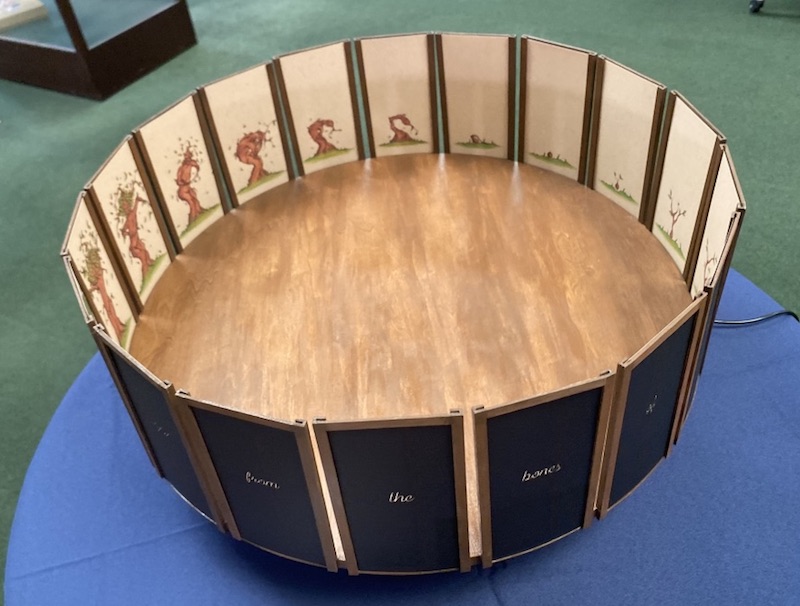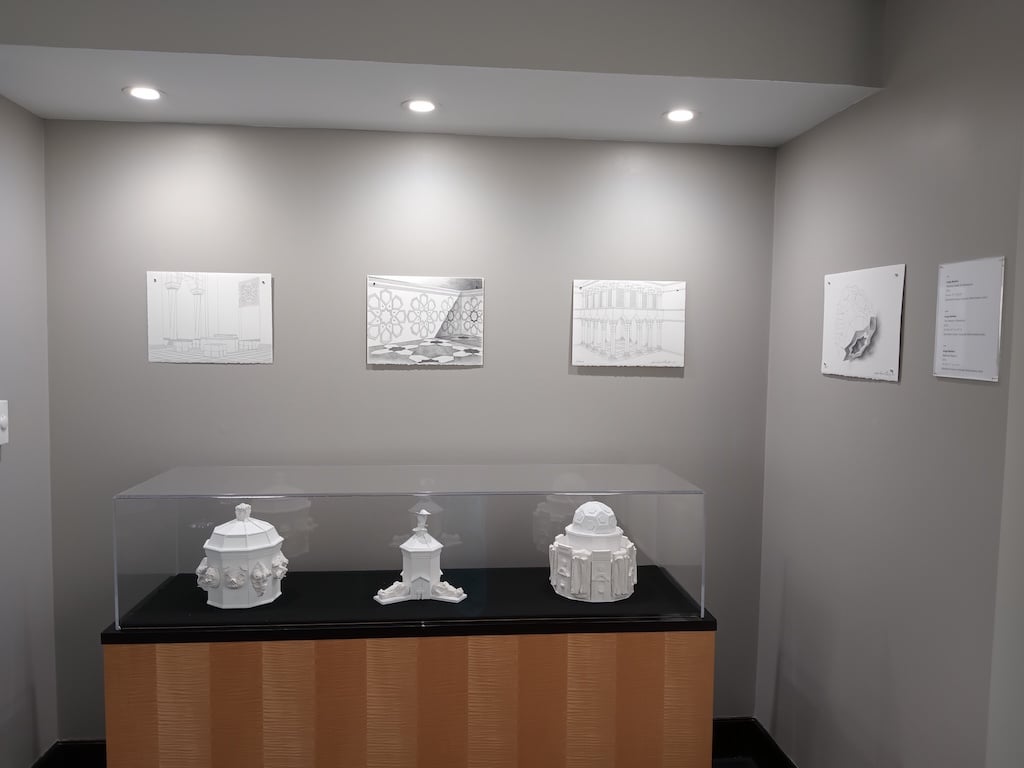Several startlingly different Atlanta art shows illustrate a point I have often tried to make — that some artworks require additional information to understand completely. To be successful, however, the works must also have an immediate impact. In these cases, all of them do.
The Haunts of Black Kirby: An exhibition of works from the dawn of Afrofuturism, at the ArtsXchange through October 28, is curated from the works in a 2019 show at the Atlanta University Center Robert W. Woodruff Library. It requires, at minimum, some understanding of the legacy of comic book creator Jack Kirby, transmuted in the service of Afrofuturist goals by artists John Jennings and Stacey Robinson.
The ArtsXchange has accepted the challenge of educating the audience by arranging two events with the Atlanta University Center: a September 30 ArtsXchange Community Discussion: Afrofuturism, Its Relevance in Today’s Environment & the Path Forward for Artists and an October 4 archival special viewing at the University Center Library, Afro-Surrealism, the Negritude Movement, and the Archival Roots of Afrofuturism.

At Hammonds House through October 21, Edouard Duval-Carrié’s Histories and Others is based on the well-known history of Haiti’s self-liberation from French rule. So it’s useful to know at least who Toussaint, Dessalines and King Henri were, since they are mentioned in artwork titles. But the main impact of the exhibition derives from Duval-Carrié’s breathtaking ability to create a complex composition in the difficult art of engraving on Plexiglas, and then surrounding the works with mirrored frames he also devises.
King Henri and Haiti’s Royal Court fills an entire wall with an image that is not a depiction of the famous Sans-Souci Palace, but a surreal, image-crowded evocation of it. The king’s face is composed of floral and vegetal elements like those of Giuseppe Arcimboldo’s Renaissance portraits. It is Duval-Carrié’s appropriate homage to the way the palace demonstrated that recently enslaved architects and artisans could create buildings and artworks rivaling those of Europe. King Henri’s contemporaries noted this too.
None of this historical information is in the exhibition, but in truth it’s secondary to the overwhelming impact of the work itself. The label for this monumental artwork describes only the impressive technique that went into its making.
By coincidence, an explicitly articulated view of history from the perspective of growing up Black and queer in the South infuses the stunning and similarly monumental woodcut prints on fabric of Kiara Gilbert. Two of these can be seen through October 13 in AURA, an exhibition of 21 female and nonbinary artists at Kai Lin Art. (Regrettably, the Leap Year Artist’s solo show A Balm to Soothe the Flesh at MINT has closed.) The two works at Kai Lin lack the interpretive explanation presented at MINT in Gilbert’s wall text, but the linear qualities and 96-inch height of Pecan Season establish a context on their own.
Visitors to Myth & Magic: The Book as Art, Volume 11, at Decatur Library Gallery through October 30, will find great pleasure in diving deeper into the informative artist statements on the bookasart.com webpage of the four sponsoring organizations. This year’s national and international entrants into the juried exhibition demonstrate unusually intense concern for the state of the world around them. Consider these titles for instance: Your Leader Could Be a Tyrant, How to Tell by Tatana Kellner and Ann E. Kalmbach, and Ellen Winter’s What Am I Seeing?
Although Winter’s artist statement tells a slightly different story, pages with such phrases as “Zigzag of Shadows” and “Confusion of Space” suggest a world in which confidence has ebbed in anybody’s ability to perceive things unambiguously.

The theme is repeated even more forcefully in Evan Lewis’ video Everted Sanctuaries VI, in which a volume of Sherlock Holmes’ confident detective work explodes into digital shreds. These turn into a maelstrom of isolated letters before recomposing and bursting open another way.
In Endure, Ashley DeVan chooses to represent the endlessly cyclic struggle to maintain women’s rights and human rights by combining text with an old-fashioned zoetrope — a cylinder with vertical slits that creates a moving image when a succession of pictures were viewed through the rotating drum.
And the Yorkshire artist Carolyn Thompson offers an altered copy of Margaret Atwood’s The Handmaid’s Tale in which she obliterated every word — except ones relating to silencing — with the word “silenced.” In a 14-day performance, she hand wrote the word 65,000 times.
Geometrie Aljamia: A Cultural Transliteration, at the Robert C. Williams Museum of Papermaking through December 6, offers aesthetic satisfaction but raises many unanswered questions. The curator’s statement says this six-artist show is united by their shared interest in geometric patterns inherited from Islamic cultures, geometry that reflects “the larger hybrid relationship that the West shares with the Middle East.” They also reflect the historic fact that “since ancient times, geometric perfection has been thought to convey sacred and universal truths.”

This gives the visitor limited context for the unexpectedly intense emotional impact of the cut paper wall hangings and graphite wall drawings by Tamin Sahebzada, Julia Townsend, Mohammed Saleh Amin, Hanane Korchi, and Reni Gower, a multinational collaboration that evolved out of a workshop held by Virginia Commonwealth University in 2013 in Qatar.
Jorge Benitez’s often witty architectural models and drawings are another matter. Based on the same geometry, they bear such provocative titles as The School of Social Engineering and Recuerdos de 1492. The “memories of 1492” are almost certainly about the end of centuries of Muslim rule in Spain. This occurred when Spain expelled or forcibly converted its Jewish population and, in the same year, sponsored the sea voyage of an Italian sailor searching for a westward route to India.
Visitors unaware of this history may remember Christopher Columbus, but not understand the whole history behind Benitez’s title. Context counts.
::
Dr. Jerry Cullum’s reviews and essays have appeared in Art Papers magazine, Raw Vision, Art in America, ARTnews, International Review of African American Art and many other popular and scholarly journals. In 2020 he was awarded the Rabkin Prize for his outstanding contribution to arts journalism.

